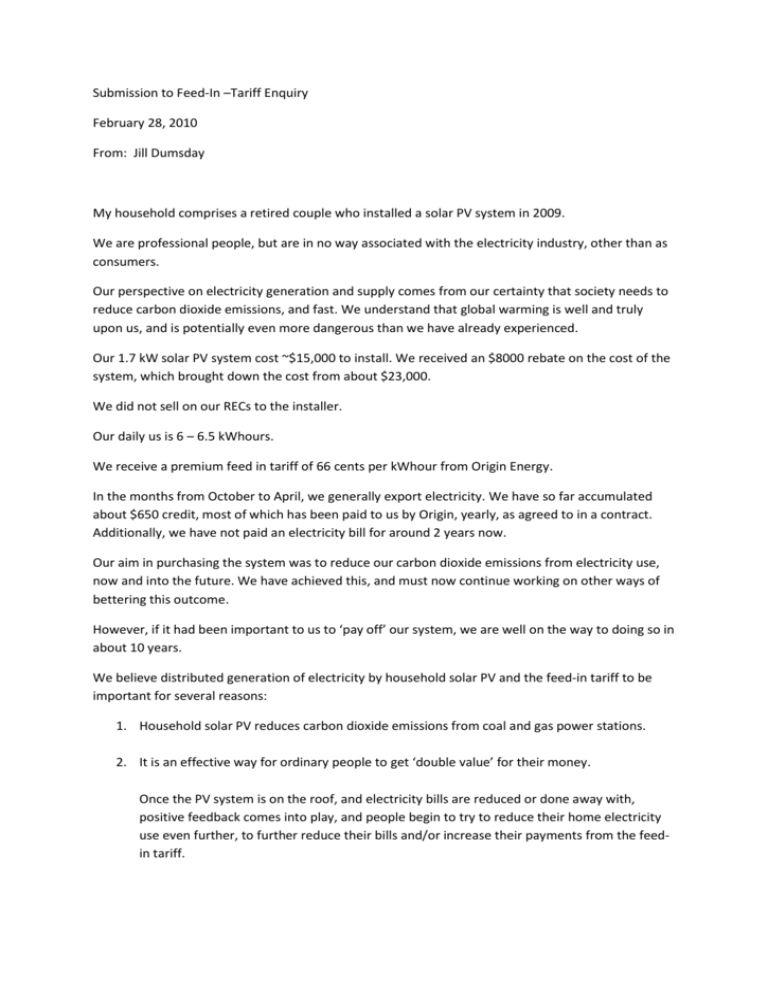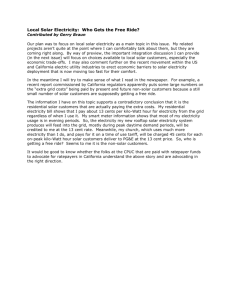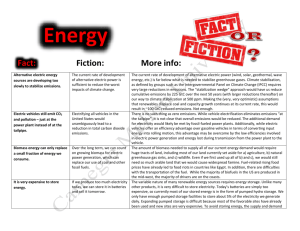03 - Jill Dumsday (DOCX 20kb)
advertisement

Submission to Feed-In –Tariff Enquiry February 28, 2010 From: Jill Dumsday My household comprises a retired couple who installed a solar PV system in 2009. We are professional people, but are in no way associated with the electricity industry, other than as consumers. Our perspective on electricity generation and supply comes from our certainty that society needs to reduce carbon dioxide emissions, and fast. We understand that global warming is well and truly upon us, and is potentially even more dangerous than we have already experienced. Our 1.7 kW solar PV system cost ~$15,000 to install. We received an $8000 rebate on the cost of the system, which brought down the cost from about $23,000. We did not sell on our RECs to the installer. Our daily us is 6 – 6.5 kWhours. We receive a premium feed in tariff of 66 cents per kWhour from Origin Energy. In the months from October to April, we generally export electricity. We have so far accumulated about $650 credit, most of which has been paid to us by Origin, yearly, as agreed to in a contract. Additionally, we have not paid an electricity bill for around 2 years now. Our aim in purchasing the system was to reduce our carbon dioxide emissions from electricity use, now and into the future. We have achieved this, and must now continue working on other ways of bettering this outcome. However, if it had been important to us to ‘pay off’ our system, we are well on the way to doing so in about 10 years. We believe distributed generation of electricity by household solar PV and the feed-in tariff to be important for several reasons: 1. Household solar PV reduces carbon dioxide emissions from coal and gas power stations. 2. It is an effective way for ordinary people to get ‘double value’ for their money. Once the PV system is on the roof, and electricity bills are reduced or done away with, positive feedback comes into play, and people begin to try to reduce their home electricity use even further, to further reduce their bills and/or increase their payments from the feedin tariff. This is a doubly powerful mechanism as it is local and immediate as well as global. A household’s efforts bring tangible results in monetary terms for them personally, as well as in effective emission reduction for the planet. Therefore, whatever the household’s motive is in installing solar, there is a ‘greater good’ outcome as well as a personal, monetary outcome. The feed-in tariff and solar PV is therefore a highly effective tool for reducing emissions, because of this double effect. Householders see this, and like it, as shown by the greater than expected take-up rate of solar PV. (This was also seen by the take-up rate for the much maligned home insulation initiative). 3. If treated as a ‘serious’ electricity source by the electricity industry, not simply an annoyance, and if integrated properly into the distribution network, it should reduce our vulnerability to supply interruption caused by power station breakdown. The barriers to distributed generation, as I see them, are: 1. The cap on the size of the solar PV system that can be installed by households. If a roof can fit a system greater than 5kW, and the householder will pay for this, then let them install it. If there are technical difficulties in feeding in large quantities of generated power to the grid, then allocate funding to research and development to fix this problem. Do not listen to power retailers bleating about costs. When our coal fired stations were initially built, the costs were great. But a power station was a necessity, and we used coal, which was fine in its day, and we bore the cost (and it was taxpayers then who supported the SEC etc). Now, it is reducing emissions that is the necessity, so let’s bite the bullet and pay for new ‘energy source integration’ technology research and development, if it is indeed needed, instead of relying on what is now outmoded, dangerous, electricity generation. 2. The Renewable Energy Certificate (REC) system. This was introduced, as I understand it, to allow emissions trading. At the moment, with more than expected households installing solar PV, there is a glut of RECs, and they are not an effective mechanism; they are worth less that predicted, and represent an outlay by installers that they cannot recoup. Get rid of RECs, which will stop this stockpiling, and most importantly, will not give big polluters a way of riding on householders’ backs with emission reduction. We did not sell our RECs, as we wanted to actually reduce emissions, not pass our contribution on to a company which did nothing to reduce theirs, except shuffle money and paper around. RECs remove the ‘credit for where credit is due’ principle. Banishing RECs should also bring down the cost of solar PV systems and make them even more accessible to householders. 3. Retain the principle of a feed-in tariff for net electricity export by households, as is in place now. For reasons outlined above, the feed-in tariff system works for householders. As long as they are being paid more for their exports than they pay for imported electricity, they will feel that their investment in solar PV is both good for their wallets, and good for the environment. 4. Remove the ban on extending an existing rooftop system. We have found that refrigeration is the main year round user of electricity. If we could legally install a couple more panels, we could more nearly cover our winter refrigeration. But our contract with Origin disallows extension of our system. Remove this disincentive to reduce emissions, and allow distributed generation to be an even more powerful tool to do so. Why is this restriction in place in the first place? Is it to reduce the paperwork of the retailers? This is not a good enough reason, it is short-sighted of them, and does not address what could be a way for them to continue ‘making a living’ in a reduced emissions world. I am well aware that this submission does not address the majority of concerns outlined in your Issues Paper. But I probably represent many ordinary Australian householders who are desperate to see their governments take some meaningful steps to address large-scale emission reduction. Solar PV, if on every roof in Australia, (as seems to be the intention in Germany) would go a long way towards covering daytime electricity use, especially if coupled with wind and solar thermal etc. Technology for grid supplementation of this electricity supply from natural gas on unfavourable days would quickly become available if governments were serious about changing to renewables. Ordinary people are leading the way here. We hope that our governments will quickly follow our lead.








